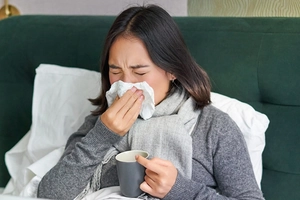
Advertisement:


Table of Contents
Flu, Pneumonia, and Your Health: A Guide for Filipinos on Symptoms, Treatment, and Prevention 🇵🇭
Living in the Philippines, we’re no strangers to respiratory illnesses like the flu (trangkaso) and pneumonia (pulmonya). These conditions, especially prevalent during the rainy season, can range from mild discomfort to serious health threats.
This comprehensive guide provides essential information on flu symptoms, influenza symptoms, pneumonia symptoms, their causes, potential complications, key differences, treatment options (both home remedies and medical care), and the availability of vaccines in the Philippines. It’s crucial to be informed so you can protect yourself and your loved ones.
Understanding the Culprits: Flu vs. Pneumonia
While both influenza (flu) and pneumonia can affect the respiratory system, they are distinct illnesses:
- Influenza (Flu): A contagious respiratory illness caused by influenza viruses that infect the nose, throat, and sometimes the lungs. It spreads easily through droplets when an infected person coughs, sneezes, or talks.
- Pneumonia: An infection that inflames the air sacs in one or both lungs. These air sacs may fill with fluid or pus, causing cough with phlegm or pus, fever, chills, and difficulty breathing. Pneumonia can be caused by various agents, including bacteria, viruses (including influenza viruses), and fungi.
Key Differences Summarized:
| Feature | Influenza (Flu) | Pneumonia |
|---|---|---|
| Cause | Influenza viruses (primarily types A and B) | Bacteria, viruses (including influenza), fungi |
| Affected Area | Primarily upper respiratory tract (nose, throat), sometimes lungs | Air sacs (alveoli) in the lungs |
| Onset | Sudden | Can be sudden or gradual |
| Severity | Usually milder than pneumonia, but can be severe, especially in vulnerable groups | Can range from mild to life-threatening, depending on the cause, the person’s age, and overall health |
| Sputum/Phlegm | Less Common, clear or white | More common and can be thick, yellow, green, or bloody |
| Chest Pain | Less Common | Sharp chest pain, especially when breathing deeply or coughing |
Recognizing the Symptoms: Don’t Ignore the Signs
Flu Symptoms / Influenza Symptoms:
- Fever: Often high (38°C or higher) and sudden onset.
- Chills: Feeling cold and shivering.
- Cough: Typically dry and persistent.
- Sore Throat: Pain or scratchiness in the throat.
- Runny or Stuffy Nose: Congestion or discharge.
- Muscle or Body Aches: General pain, often severe.
- Headache: Can be intense.
- Fatigue: Extreme tiredness and weakness.
- Vomiting and Diarrhea: More common in children.
Pneumonia Symptoms:
- Cough: Often produces phlegm (mucus) that may be yellow, green, brown, or tinged with blood.
- Fever: May be high or low grade.
- Chills: Can be severe, with shaking.
- Shortness of Breath: Difficulty breathing, even at rest.
- Chest Pain: Sharp or stabbing pain that worsens with deep breaths or coughing.
- Rapid Heartbeat: Faster than normal pulse.
- Fatigue: Extreme tiredness.
- Loss of Appetite
- Bluish lips or nails (due to the lack of oxygen)
Important Note: Flu symptoms and pneumonia symptoms can overlap, especially in the early stages. If you experience severe symptoms or your condition worsens, seek medical attention immediately.
Causes and Complications: Understanding the Risks
Causes:
- Flu: Caused by influenza viruses, primarily types A and B. These viruses spread through respiratory droplets produced when an infected person coughs, sneezes, or talks. You can also get the flu by touching a surface with the virus on it and then touching your mouth, nose, or eyes.
- Pneumonia:
- Bacterial Pneumonia: Commonly caused by Streptococcus pneumoniae.
- Viral Pneumonia: Can be caused by various viruses, including influenza viruses, respiratory syncytial virus (RSV), and others.
- Fungal Pneumonia: More common in people with weakened immune systems.
Complications:
Both flu and pneumonia can lead to serious complications, particularly in:
- Young children (especially those under 5 years old)
- Adults aged 65 and older
- Pregnant women
- People with chronic medical conditions (e.g., asthma, diabetes, heart disease, HIV/AIDS)
- People with weakened immune systems
Flu Complications:
- Pneumonia: The flu virus can directly cause viral pneumonia or make you more susceptible to bacterial pneumonia.
- Bronchitis: Inflammation of the bronchial tubes.
- Sinus Infections: Inflammation of the sinuses.
- Ear Infections: More common in children.
- Worsening of chronic conditions: The flu can trigger asthma attacks, worsen heart failure, and complicate diabetes.
Pneumonia Complications:
- Respiratory Failure: Severe difficulty breathing that may require mechanical ventilation.
- Sepsis: A life-threatening condition caused by the body’s overwhelming response to an infection.
- Lung Abscess: A collection of pus that forms in the lung tissue.
- Pleural Effusion: Fluid buildup in the space between the lungs and chest wall.
- Bacteremia: Bacteria from the lungs entering the bloodstream.
Home and Medical Treatment: Finding Relief
Home Care for Flu and Mild Pneumonia:
- Rest: Get plenty of rest to help your body fight the infection.
- Hydration: Drink lots of fluids (water, juice, clear broth) to prevent dehydration. Sabaw is a popular and comforting choice in the Philippines.
- Over-the-Counter (OTC) Medications:
- Pain Relievers/Fever Reducers: Paracetamol (e.g., Biogesic, Tempra) or ibuprofen can help relieve fever, body aches, and headache.
- Decongestants: Can help relieve nasal congestion.
- Cough Suppressants: May help reduce coughing, but consult your doctor before using them, especially for productive coughs.
- Humidifier or Steam Inhalation: Can help ease congestion and soothe a sore throat. Pagsuob (steam inhalation) is a traditional Filipino remedy.
- Saltwater Gargle: Gargling with warm salt water can help relieve a sore throat.
- Honey: A teaspoon of honey can soothe a cough (not for children under 1 year old).
Medical Treatment:
- Flu:
- Antiviral Medications: If taken within 48 hours of symptom onset, antiviral drugs like oseltamivir (Tamiflu) can shorten the duration of the flu and reduce the risk of complications. These medications require a doctor’s prescription.
- Pneumonia:
- Antibiotics: For bacterial pneumonia, antibiotics are essential. The specific antibiotic will depend on the type of bacteria causing the infection.
- Antivirals: For viral pneumonia caused by influenza, antiviral medications may be prescribed.
- Oxygen Therapy: If blood oxygen levels are low, supplemental oxygen may be needed.
- Hospitalization: Severe cases of pneumonia may require hospitalization for intravenous fluids, antibiotics, respiratory support, and close monitoring.
When to Seek Medical Attention:
- Difficulty breathing or shortness of breath
- Persistent chest pain or pressure
- Confusion or disorientation
- Inability to keep fluids down
- Severe or persistent vomiting
- Symptoms that improve but then return with fever and worse cough
- Bluish lips or face
- High fever that doesn’t improve with medication
- You belong to a high-risk group
Vaccines Available in the Philippines and Guide for General Public
Flu Vaccine:
- Availability: Flu vaccines are widely available in the Philippines through public health centers (barangay health centers), hospitals, and private clinics.
- Types: Most flu vaccines available are quadrivalent, protecting against four different flu viruses (two influenza A and two influenza B).
- Who Should Get Vaccinated: The Department of Health (DOH) recommends annual flu vaccination for everyone six months and older, especially high-risk groups.
- When to Get Vaccinated: Ideally, get vaccinated before the flu season starts (around June to November in the Philippines), but vaccination can still be beneficial even later in the season.
- Cost: Flu vaccines may be available for free at some public health centers, especially for senior citizens and other priority groups. Private clinics typically charge a fee.
Pneumonia Vaccines:
- Pneumococcal Conjugate Vaccine (PCV): Protects against 13 types of pneumococcal bacteria. Recommended for children under 2 years old, adults 65 and older, and people with certain medical conditions.
- Pneumococcal Polysaccharide Vaccine (PPSV23): Protects against 23 types of pneumococcal bacteria. Recommended for adults 65 and older and people 2 years and older with certain medical conditions.
- Availability: Pneumococcal vaccines are available in the Philippines through public health centers, hospitals, and private clinics.
- Cost: Similar to flu vaccines, pneumococcal vaccines may be free at some public health centers for priority groups.
Guide for the General Public in the Philippines:
- Consult Your Doctor: Discuss with your doctor or healthcare provider about the most appropriate vaccines for you and your family based on age, health status, and risk factors.
- Check with Your Local Health Center: Inquire about the availability of free or subsidized vaccines at your barangay health center.
- Consider Private Clinics: If free vaccines are not available or if you prefer to get vaccinated at a private clinic, inquire about the cost and schedule.
- Keep Records: Maintain a record of your vaccinations, including the date and type of vaccine received.
- Practice Good Hygiene: Even with vaccination, continue practicing good hygiene habits like handwashing, covering coughs and sneezes, and staying home when sick to prevent the spread of respiratory illnesses.
Frequently Asked Questions (FAQ)
Can the flu shot give me the flu?
No, the flu shot cannot give you the flu. The viruses in the flu shot are either inactivated (killed) or weakened, so they cannot cause infection.
Is it safe to get the flu and pneumonia vaccines at the same time?
Yes, it is generally safe to get the flu and pneumonia vaccines at the same time, but consult your doctor for personalized advice.
What’s the best way to prevent the spread of flu and pneumonia?
Vaccination, frequent handwashing, covering coughs and sneezes, staying home when sick, and disinfecting frequently touched surfaces are key preventive measures.
How long does it take to recover from the flu?
Most people recover from the flu within a week or two, but some symptoms, like fatigue, can last longer.
How long does it take to recover from pneumonia?
Recovery from pneumonia can take several weeks or even months, depending on the severity of the infection and the individual’s overall health.
Conclusion: Protecting Yourself and Your Community
Flu and pneumonia are serious respiratory illnesses that can significantly impact your health. Recognizing the flu symptoms, understanding the differences between flu and pneumonia symptoms, and knowing when to seek medical help are essential for timely diagnosis and treatment.
Vaccination against both influenza and pneumococcal disease is a crucial preventive measure, especially for vulnerable individuals. By staying informed, practicing good hygiene, and seeking appropriate medical care, we can protect ourselves, our families, and our communities from these potentially life-threatening illnesses.
Remember to consult your doctor for personalized advice and treatment. Ingat po tayo lagi!
Disclaimer:
Pinoy Trending informs that this article is intended for informational purposes only and should not be considered medical advice. Always consult with a qualified healthcare professional for any health concerns or before making any decisions related to your health or treatment.
The information provided here may not be completely up-to-date, always refer to official sources like the Department of Health (DOH) for the latest guidelines and recommendations.
References:
- Centers for Disease Control and Prevention (CDC). (2023). Influenza (Flu). Retrieved from https://www.cdc.gov/flu/
- World Health Organization (WHO). (2023). Influenza (Seasonal). Retrieved from https://www.who.int/news-room/fact-sheets/detail/influenza-(seasonal)
- Mayo Clinic. (2023). Influenza (flu). Retrieved from https://www.mayoclinic.org/diseases-conditions/flu/symptoms-causes/syc-20351719
- Mayo Clinic. (2023). Pneumonia. Retrieved from https://www.mayoclinic.org/diseases-conditions/pneumonia/symptoms-causes/syc-20354204
- Department of Health (DOH) Philippines. (n.d.).
- National Immunization Program. Philippine Foundation for Vaccination. (n.d.). Adult Immunization. Retrieved from https://www.philvaccine.org/adult-immunization
- Lung Center of the Philippines. (n.d.). Pneumonia.
Josh is a seasoned content writer and journalist with over 15 years of experience creating impactful, accurate, and engaging content across industries like technology, healthcare, finance, and media. He specializes in translating complex topics into clear, accessible narratives and excels in technical documentation, editorial writing, and marketing materials.
A skilled journalist, Josh delivers in-depth features and articles that resonate with readers. Known for his attention to detail, research skills, and reliability, he is dedicated to producing high-quality content that informs, educates, and inspires.


